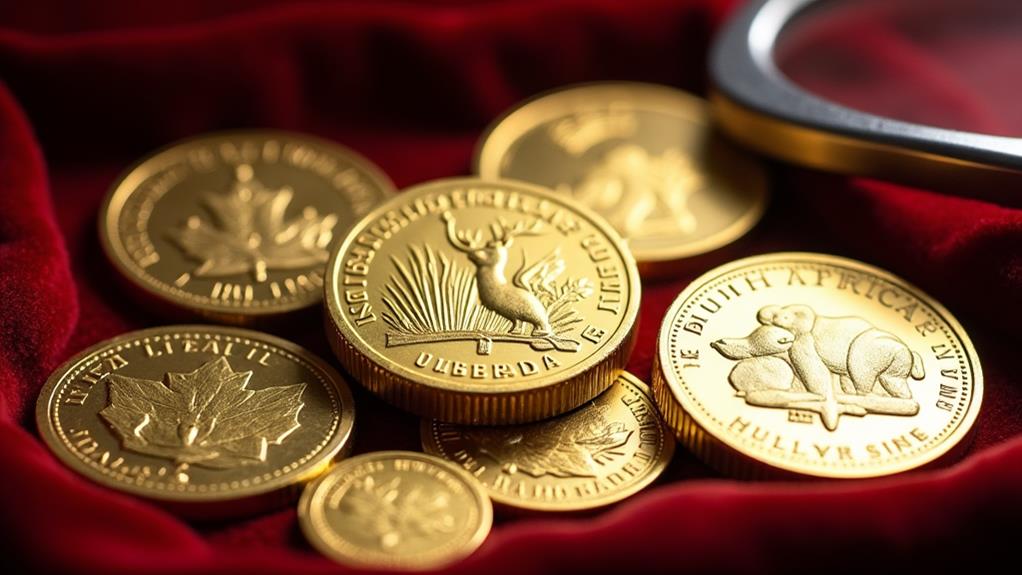Investing in gold coins can be an intriguing addition to a diversified portfolio, but it requires careful consideration. From bullion to rare collectibles, the world of gold coins offers various options, each with its own set of advantages and challenges. Prospective investors must steer through factors such as purity, market trends, storage requirements, and tax implications. Furthermore, understanding the interplay between gold coin investments and overall financial strategies is essential. As the allure of these precious metal assets continues to captivate investors, a deeper exploration of the fundamental considerations can help determine whether gold coins align with one's investment goals.
Key Insights
- Evaluate the purity, weight, and premium over spot price of gold coins to understand their true value.
- Consider storage and security options, including associated costs and insurance requirements.
- Assess the liquidity and resale potential of specific gold coins in various market conditions.
- Understand tax implications, including capital gains rates and reporting requirements for gold coin investments.
- Determine the appropriate allocation of gold coins within your overall investment portfolio for diversification purposes.
Types of Gold Coins

Among the various options for investing in gold, coins offer a unique combination of historical significance and intrinsic value. Gold bullion coins, such as the American Gold Eagle, Canadian Gold Maple Leaf, and Krugerrand, are popular choices for investors seeking physical gold storage.
These investment coins typically trade at a small premium above the spot price of gold, reflecting their minting costs and demand. Some gold coins likewise possess numismatic value, which can increase their worth beyond their gold content.
Nevertheless, this additional value can be subjective and volatile. When evaluating gold coins for investment, it's essential to understand the difference between bullion and collectible coins.
Investors should evaluate factors such as:
- Purity and weight of the gold content
- Premium over spot price
- Liquidity and marketability
- Storage and insurance costs
Gold coins offer a tangible asset that can help preserve purchasing power over time.
Purity and Weight Factors
When reflecting on gold coins for investment, understanding purity and weight factors is important. Gold coins are typically measured in troy ounces, with purity expressed as a percentage or in karats. The American Eagle, a popular choice, contains 1 troy ounce of pure gold but is alloyed for durability.
| Coin Type | Purity | Weight |
|---|---|---|
| American Eagle | 91.67% (22K) | 1 troy oz |
| Canadian Maple Leaf | 99.99% (24K) | 1 troy oz |
| South African Krugerrand | 91.67% (22K) | 1 troy oz |
Investors should consider:
- Purity affects value: Higher purity generally means higher worth
- Weight impacts price: Heavier coins cost more
- Rare coins may have collectible value beyond gold content
- Bullion coins are priced closer to spot gold prices
Expert Quote: "Understanding purity and weight is vital for making informed decisions when buying gold coins as a tangible asset."
Market Dynamics and Pricing

Numerous factors influence the market dynamics and pricing of gold coins, making it a complex landscape for investors to steer. The price of gold, which fluctuates based on global economic conditions, serves as the foundation for coin valuations.
Nevertheless, other elements, such as rarity, historical significance, and collector demand, can significantly impact a coin's worth.
Market volatility mitigation is an essential consideration when incorporating gold coins into an investment portfolio. While precious metals, including gold bars and coins, can provide portfolio diversification, their prices can be subject to rapid changes.
Investors must carefully time their decisions to buy and sell, aligning with their overall investment strategy.
Expert Quote: "Understanding market dynamics is vital for successful gold coin investing. Investors should monitor global economic indicators, geopolitical events, and supply-demand trends to make informed decisions."
Storage and Security Concerns
When investing in gold coins, proper storage and security are essential concerns.
Investors must carefully consider safe storage options, such as home safes, bank safety deposit boxes, or specialized precious metal depositories, each with its own set of advantages and drawbacks.
Moreover, obtaining adequate insurance coverage for gold coin investments is vital to protect against potential loss, theft, or damage.
Safe Storage Options
Safeguarding gold coins is a significant consideration for investors who have incorporated these precious assets into their portfolios. When deciding to invest in gold as a safe haven asset for wealth preservation, it's vital to understand the various storage options available. Here's a comparison of common storage methods:
| Storage Option | Security Level | Accessibility | Cost |
|---|---|---|---|
| Home Safe | Moderate | High | Low |
| Bank Safe Deposit Box | High | Limited | Moderate |
| Private Vault | Very High | Moderate | High |
| Allocated Storage | High | Low | Moderate |
| Custodian Service | Very High | Low | High |
Each option has its pros and cons, and investors should carefully evaluate their needs, taking into account factors such as security, accessibility, and cost. It's important to choose a storage method that aligns with your investment goals and risk tolerance when holding physical gold in your portfolio.
Insurance Considerations
Given the value and crucial risks associated with storing physical gold coins, insurance considerations become critical for investors. When adding gold coins to a diversified portfolio or gold IRA for retirement, proper insurance is vital for risk management.
Investors should carefully evaluate their asset allocation and consider the following factors:
- Coverage limits for precious metals in standard homeowners policies
- Specialized insurance options for high-value coin collections
- Riders or endorsements for additional protection
- Appraisal requirements for accurate coverage
Gold coins, as a long-term investment and potential hedge against economic uncertainty, require strong insurance protection.
Investors must assess their specific needs based on the value of their holdings and storage methods. Consulting with insurance professionals experienced in precious metals can help ensure adequate coverage.
Liquidity and Resale Potential

When contemplating gold coins as an investment, it's essential to understand their liquidity and resale potential.
Market demand for gold coins can fluctuate, impacting their value and ease of sale at any given time.
The accessibility of dealer networks plays a significant role in an investor's ability to quickly convert gold coins into cash, with larger cities typically offering more options for buying and selling.
Market Demand Fluctuations
Market demand for gold coins can significantly impact their liquidity and resale potential, making it an important factor for investors to consider. When adding gold coins to an investment portfolio, understanding market demand fluctuations is vital for making informed decisions.
Factors influencing demand include:
- Economic uncertainty
- Currency devaluation concerns
- Geopolitical tensions
- Shifts in investor sentiment
These fluctuations can affect an investor's ability to buy or sell gold coins at desired prices. While gold coins are often viewed as a long-term store of value and hedge against currency devaluation, their market demand can be unstable in the short term.
This volatility may impact potential capital appreciation and overall portfolio performance. Investors should carefully assess their investment goals, risk tolerance, and market conditions before incorporating gold coins into their diversification strategy.
Regular monitoring of market trends and demand patterns is important for maximizing the benefits of this unique asset class.
Dealer Network Accessibility
A strong dealer network forms the backbone of liquidity and resale potential for gold coin investments. When evaluating gold coins as an investment option, accessibility to a reliable dealer network is essential. This network ensures investors can buy and sell gold assets efficiently, affecting the overall liquidity of their investment.
Key points to evaluate:
- Reputable dealers offer fair prices for buying and selling gold coins
- A wide dealer network provides more options for investors
- Local and online dealers expand accessibility
Investment advice often emphasizes the importance of researching dealer reputations before engaging in gold coin transactions.
As one expert notes, "A trustworthy dealer network can make the difference between a smooth investment experience and a frustrating one."
When comparing gold bars and coins, coins often benefit from a more extensive dealer network, potentially enhancing their appeal as an investment choice.
Authenticity and Certification
Ensuring the authenticity of gold coins is vital when adding them to an investment portfolio. Reputable dealers and certification services play a significant role in verifying the legitimacy of gold coins, reducing the risks associated with counterfeit products.
When evaluating gold coins as an investment asset, investors should:
- Obtain certificates of authenticity from recognized grading services
- Verify the coin's weight, purity, and mint marks
- Research the coin's historical significance and rarity
- Consult with experienced numismatists or precious metals experts
Certification provides assurance of a coin's authenticity, grade, and value, which is important for accurate portfolio valuation.
While gold coins offer exposure to gold and potential numismatic value, investors must be aware of the risks involved in gold investing. Thorough due diligence and professional guidance can help mitigate these risks, ensuring that gold coins serve as a valuable addition to an investment portfolio.
Tax Implications

While establishing the authenticity of gold coins is vital, investors must similarly consider the tax implications of adding these assets to their portfolios.
In the United States, gold coins are typically treated as collectibles for tax purposes, subject to a maximum long-term capital gains rate of 28%. This rate applies when you sell physical gold for a profit after holding it for more than one year.
Short-term investment gains on gold coins, held for less than a year, are taxed as ordinary income.
It is essential to note that some gold coins, such as American Eagle coins, are exempt from certain reporting requirements.
Nonetheless, investors should consult with a tax professional to understand the specific implications of owning gold coins in their portfolios.
Keep accurate records of your gold transactions to ensure proper reporting and maximize your return on investment.
Portfolio Diversification Strategy
Incorporating gold coins into an investment portfolio serves as a powerful diversification strategy, potentially reducing overall risk and enhancing long-term returns. Gold's non-correlated nature with traditional assets like stocks and bonds makes it an attractive option for portfolio diversification.
When taking into account adding gold to your portfolio, investors should evaluate:
- The optimal percentage of gold holdings
- Various ways to invest in gold, including coins, bullion, or ETFs
- The impact on overall portfolio volatility
- Long-term storage and security considerations
Building a portfolio with gold investments can provide a hedge against economic uncertainties and inflation.
Nevertheless, it's essential to balance the potential benefits with the costs and risks associated with holding physical gold. Investors should carefully assess their financial goals, risk tolerance, and existing asset allocation before making significant investments in gold coins or other forms of gold.
Long-Term Investment Outlook

Taking into account the long-term investment outlook, gold coins have historically demonstrated potential as a store of value and a hedge against economic uncertainties.
Gold's non-correlated nature with traditional assets can provide portfolio stability during market volatility. As an inflation hedge, gold typically retains its purchasing power when the value of the dollar declines.
Nevertheless, it is essential to note that gold isn't a guaranteed investment, and the price of gold goes through cycles like any other asset.
Investors should consider the amount of gold to include in their portfolio carefully. While gold can be a good long-term investment, it is typically recommended to allocate only a small percentage of one's portfolio to precious metals.
Gold is typically viewed as a defensive asset, offering protection against economic downturns rather than significant growth potential.
My Final Thoughts
In the glittering domain of gold coin investments, prudence outshines impulsivity. Shrewd investors chart a labyrinth of considerations, from purity percentages to tax pitfalls, before succumbing to the siren call of numismatic treasures. While the allure of tangible wealth calls, one must weigh the scales of risk and reward carefully. Gold coins may promise a hedge against economic uncertainty, but they demand a discerning eye and unwavering resolve. The path to golden profits is paved with diligence, research, and strategic foresight.







